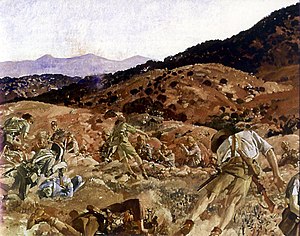Battle of the Nek
| Battle of the Nek | |||||||
|---|---|---|---|---|---|---|---|
| Part of World War I | |||||||
 The charge of the 3rd Light Horse Brigade at the Nek, 7 August 1915 by George Lambert, 1924. |
|||||||
|
|||||||
| Belligerents | |||||||
|
|
|
||||||
| Commanders and leaders | |||||||
| Alexander Godley | Mustafa Kemal | ||||||
| Units involved | |||||||
| 3rd Light Horse Brigade | 18th Regiment | ||||||
| Strength | |||||||
| 600 | |||||||
| Casualties and losses | |||||||
| 372 killed and wounded | at least 8 | ||||||
The Battle of the Nek (Turkish: Kılıçbayır Muharebesi) was a small World War I battle fought as part of the Gallipoli campaign. "The Nek" was a narrow stretch of ridge in the Anzac battlefield on the Gallipoli Peninsula. The name derives from the Afrikaans word for a "mountain pass" but the terrain itself was a perfect bottleneck and easy to defend, as had been proven during an Ottoman attack in May. It connected the Anzac trenches on the ridge known as "Russell's Top" to the knoll called "Baby 700" on which the Ottoman defenders were entrenched.
On 7 August 1915, two regiments of the Australian 3rd Light Horse Brigade mounted a futile bayonet attack on the Ottoman trenches on Baby 700, suffering 40% killed for no gain and negligible enemy casualties. The battle became known as "Godley's abattoir".
For the three months since the 25 April landings, the Anzac beachhead had been a stalemate. In August an offensive (which later became known as the Battle of Sari Bair) was intended to break the deadlock by capturing the high ground of the Sari Bair range, and linking the Anzac front with a new landing to the north at Suvla. In addition to the main advance north out of the Anzac perimeter, a number of supporting attacks were planned from the existing trench positions.
The attack at the Nek was meant to coincide with an attack by New Zealand troops from Chunuk Bair, which was to be captured during the night. The light horsemen were to attack across the Nek to Baby 700 while the New Zealanders descended from the rear onto Battleship Hill, the next knoll above Baby 700.
The 3rd Light Horse Brigade, which was fast commanded by Colonel F.G. Hughes, comprised the 8th, 9th and 10th Light Horse Regiments. Like the other Australian Light Horse and the New Zealand Mounted Rifles regiments, they had been dispatched to Gallipoli in May as infantry reinforcements, leaving their horses in Egypt.
...
Wikipedia
